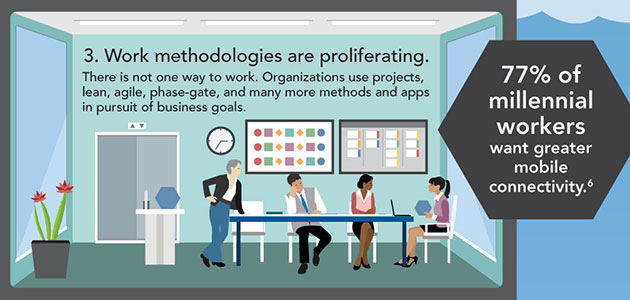
Eight forces are exerting pressure on modern organizations. In this third installment of our series, I cover the increasing number of work methods that employees at all levels are using in today’s businesses. To succeed, leaders must incorporate these into a modern approach to PPM with Work and Resource Management.
- Die Ergebnisse sind unterschiedlich
- Fähigkeiten müssen strategisch sein
- WORK METHODS ARE PROLIFERATING
- Die unstrukturierte Arbeit explodiert
- Pläne sind noch wichtiger
- Teams sind virtuell und global
- Technologie ist überall
- Die Ressourcen vermehren sich
Here’s a quick video of me introducing this concept during our recent customer conference in Austin:
Work Methods Are Proliferating
Think of the complexity of the modern organization. Achieving a company’s strategic objectives requires specialists in every area of the business. Those specialists are increasingly relying on a wide variety of work methodologies and technology applications to help them get their jobs done. These methodologies include everything from traditional project management to Lean to Agile to phase-gate – with more coming everyday.
The flexibility of this environment is a big plus but it comes with it’s own set of challenges, including getting everyone on the same page. Leaders must ensure that everyone is connected to the broader strategy and how they contribute to it. In turn, to deliver the best possible products and services to the customer, these leaders must grasp how all the work being done via these methods contributes to the whole. It’s time to incorporate all the work types in organizations into a portfolio-level view of the world.
Traditionally, PPM has focused solely on projects, which represent only one part of the way work is done in any enterprise. PPM software has had great success and remains critical to helping organizations manage their limited resources for their high profile, structured projects. Yet PPM is not enough in a world of growing work methods and unstructured, collaborative projects and tasks, which make up the largest part of any organization’s work portfolio (I will cover this in my next blog post).
This is where Work and Resource Management comes in as a way to tackle this broader set of work and resource challenges. Under this larger category, we have expanded upon our PPM roots with a comprehensive set of solutions that uniquely address, among other things, the variety of ways teams and organizations work. With a truly integrated work and resource portfolio, customers gain a higher-impact view of resources across the enterprise to better achieve their objectives.
In the world of Work and Resource Management, we are continuing to embrace our PPM roots, but expanding dramatically the frameworks for how work is done. In the WRM world we envision a holistic way to help organizations to connect strategy and execution – across all types of work and all kinds of resources. As we wrote in our whitepaper (“8 Reasons Your Business Strategy Might Just Fail”): “Without a way to harness all these work and resource elements strategically in support of an organization’s goals, the result will be inefficiency, stagnation, and even chaos.”
In my next post, I’ll cover disruptive force #4: “Unstructured work is exploding.”






